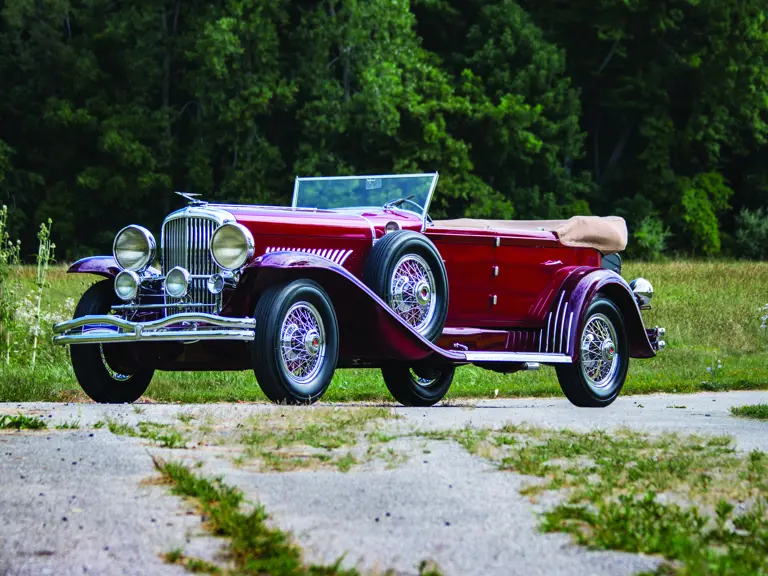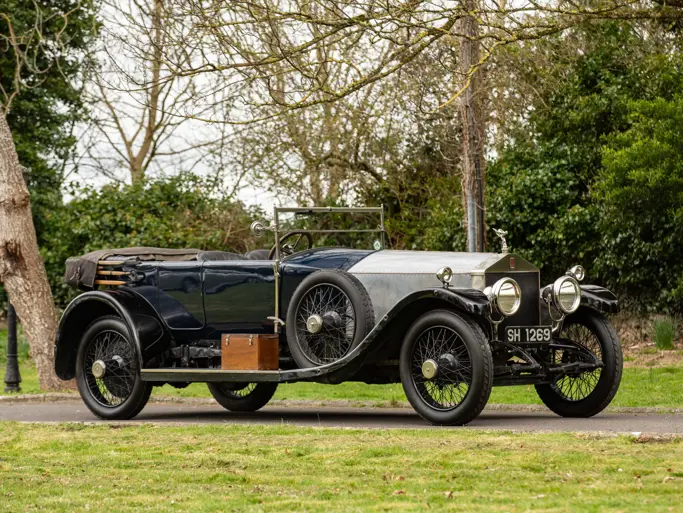
1931 Duesenberg Model J
{{lr.item.text}}
$880,000 USD | Sold
{{bidding.lot.reserveStatusFormatted}}
- 420-cid, 265-hp OHC inline eight-cylinder engine
- Three-speed manual transmission
- Timeless Murphy coachwork
- Continuous history from new
- Innovative hydraulic four-wheel drum brakes
- Very tidy older restoration
- Freshly serviced
- Fine running and driving example
The Phoenix-based newspaper, the Arizona Republic, on September 22, 1929 ran an article on the diversity of the engineering needed for the various units available from the Auburn Automobile Company due to the widely ranged price points of their new cars. The article states “The new Duesenberg, accepted as the world’s finest automobile, is a product of Duesenberg, Inc., at Indianapolis, Ind., an Auburn unit. This car has a 265 horsepower motor with a speed of well over 120 miles per hour. Engineers accept its engineering as the finest that has ever been made available to the public. The car was designed by Fred S. Duesenberg, world famous automotive engineer, who is vice-president in charge of engineering of Duesenberg, Inc.”
The December 8, 1929 edition of The Pittsburgh Press headlines read “This and That About Motor Cars and Their Makers.” One of the four adjoining bylines simply stated “Duesenberg A Sensation.” Of course they were talking of the recently introduced Duesenberg Model J, which was first presented at the New York Auto Salon on December 1, 1928. This is but one of the many headlines it made, such was its impact on the public and auto experts of the era.
Duesenberg already had an established reputation for speed and quality from their Model A road cars and the fame they had achieved on racetracks around the country and beyond, winning some of the world’s top racing events. Combining this with the elegance and grandeur of the Model J; it was the star of the show.
The Pittsburgh Press continued: “An ensemble of beauty and exclusiveness, coupled with exceptional power and speed, marked the new Duesenberg which last week was given its first official showing at the New York salon, where it proved an immediate sensation, commanding and receiving an unusual amount of interest from visitors to the exhibit of the finest products of the internationally-known automobile manufacturers and designers and body builders.
The car is the design of Fred S. Duesenberg, the famous racecar builder, and in every part and detail is markedly individual and typical of the Duesenberg trend of engineering. Innovation after innovation are presented, practically every major part and operation of the car being an advance over standard acceptance. Harmony of effect and beauty of detail mark this new car. Throughout its entire design no effort has been left undone to harmonize and to provide ease and comfort in motoring.”
At the top from day one, Duesenberg responded by ordering sufficient components to build 500 Model Js while continuing development to insure its perfection. In the June 23, 1929 Cincinnati Enquirer “Auto Row Pick Ups” column under the bold “Demand for High-Priced Car” subhead offered that “Duesenberg, Inc., builders of the world’s finest automobile, has set a new record for preduction (pre-production ed.), of cars above the $10,000 class.
Ten to 50 cars is looked on as a high production figure for a year’s production in automobiles of this price, but Duesenberg is turning out an average of one and a quarter cars daily at its Indianapolis factory while orders are coming in at the rate of two and a half cars daily. Sufficient orders are on hand to keep the factory working at capacity for the remainder of the year.
More than a million and a half dollars in commitments have been placed with custom body builders to date and the total volume of business done by the company for the year will probably be in excess of $3,000,000.”
The first delivery was executed in May 1929, at the end of October; the nation would experience the financial fall of Black Tuesday.
In spite of this; Duesenberg pressed forward with Fred Duesenberg continuing engine development to make the Model J even more powerful, applying the centrifugal supercharger to the Duesenberg’s colossal straight eight, as he had so successfully accomplished with his smaller racing engines. After Fred’s unfortunate passing from pneumonia on July 26, 1932 at age 55, (provoked by injuries from a Lincoln Highway crash near Jennerstown, Pennsylvania on the 2nd of the same month), brother August was retained to put the final touches on the supercharged Model J. Augie had been independently and successfully been building the Duesenberg racecars and the combined efforts resulted in the 320-hp “SJ” which soon was recognized as “the holy grail” of American performance luxury cars. The signature external pipes of the supercharged models would inspire generations of designers and remain – all these years later – a symbol of power and performance.
It is difficult to overstate the effect that the Duesenberg Model J had on America. Even as the Great Depression cast a pall over the nation, this exemplar of power was a signal of affluence. Duesenberg targeted the wealthy with understated ads that showed "He drives a Duesenberg" or "She drives a Duesenberg" – sophisticated ad messages under renderings of well-heeled men and women who showed no concern for the bleak economy. For such ads, the car would not be seen; only home and social settings that left no question of whose coach-houses were adorned with such a luxury.
The original newspaper articles show unequivocally that the myth and mystique garnered by the famed Duesenberg Model J over the past 80-plus years is based on fact and opinion offered in period. No embellishment is needed - then or now.
Car number 2363 was originally delivered to E. B. Henry of Detroit, Michigan in August 1930. It bore a handsome convertible sedan body by Murphy of Pasadena, California. The Walter M. Murphy Company had been formed in 1920, originally to body Lincolns, for which Mr. Murphy was the California distributor. Soon his shops were supplying bodies for Mercer, Packard, Minerva, Mercedes-Benz and Rolls-Royce chassis as well.
Murphy employed some of the finest designers on the west coast that included Frank Spring, George McQuarry, Jr., Franklin Hershey and Phillip O. Wright. It was natural that when the Duesenberg Model J was introduced, Murphy would submit design sketches to Duesenberg. By then, Murphy had established a broad reputation as the “young at heart” body builder, producing work of consistently advanced construction features and styling. Due in part to the popularity of their famed convertible coupe, the Murphy concern bodied more Duesenberg Model Js than any other coachbuilder.
When new, car number 2363 was fitted with engine J337. Mr. Henry kept the car for 16 years before selling it to Ken Seeley of Los Angeles. It is believed that Mr. Seeley exchanged the engine with that of car 2431 to the J420 it still carries today. The Murphy-bodied J then had two Hollywood owners, Gene Towne and William Thompson, followed by Dr. George Pearson of Los Angeles, who sold it to Nate Derus of Vista Del Mar in 1955.
Mr. Derus also kept the car for 16 years before selling it to Mr. Jack Finden who also kept the J for an unspecified extended period. It was later owned by Mr. Gene Storms until the late 1970s when the car became part of the Imperial Palace Collection in Las Vegas. In the mid-90s, the Duesenberg was acquired by the Atwell Collection of Fredericksburg, Texas, where it remained until becoming a member of Mr. John O’Quinn’s collection. Private ownership since Mr. O’Quinn brings the car’s history up to date.
Displaying an older restoration, this Duesenberg retains a wonderful patina and displays no major flaws. The tan leather interior “looks its age” but has no significant issues or flaws. The engine-turned instrument panel is nicely detailed, and the instruments have also been well-restored. The engine compartment and undercarriage are both presented in a tidy fashion. The car has been certified by the Auburn Cord Duesenberg Club with number D-150. Further confirmation comes from previous writings and findings from multiple, well-respected Duesenberg historians.
This beautifully designed Murphy Convertible Sedan is dignified with elegant sportiness, attractive colors and chromed wire wheels with blackwall tires for open air touring at its finest. The dual sidemounts are exposed and the interior is nicely accented by the tidy tan canvas top and black trunk. Long sweeping lines relieved of all harshness and predominance with a combined richness and beauty that sets the car apart. Radiator and hood are higher than most cars of the era; while the body is low-slung, giving the idea of enormous speed possibilities. Front fenders are long and sweeping, extending back past the center of the car thus adding to the appearance of fleetness. Even the large size of the car accentuates the fleetness, and the 142-1/2 inch standard wheelbase adds materially to it. The signature large headlights are complemented by twin cowllights and taillights; while further detail is seen with tantalizing, flowing door handles and Murphy body badges on each side of the lower cowl.
Duesenberg J420 has recently received service and is a fine running and driving example that will be welcome at events throughout the hobby. Of course, when selecting a Model J Duesenberg, the new owner is afforded membership into one of the most exclusive collector car circles in the world.


 | Auburn, Indiana
| Auburn, Indiana


